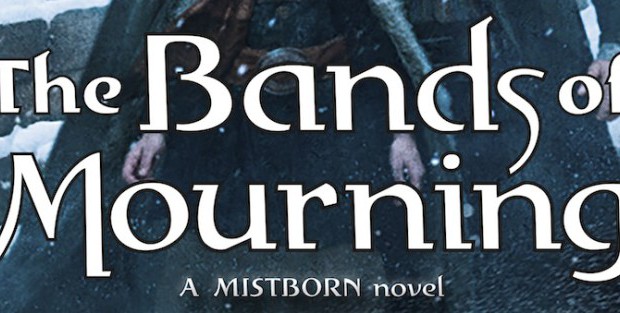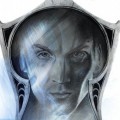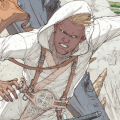As we come to the end of another fantasy series from bestseller Brandon Sanderson, I wouldn’t blame you if you were wondering how he manages to keep up such a grueling publishing schedule. Along with his Mistborn novels, the finale of The Reckoners series is released in the early part of this year, other novellas and short stories are continuing to pop up, as is the third installment of The Stormlight Archive (when I met Brandon late last year he said the next Stormlight book should be out November 2016, if he sticks to his deadlines – come on, Brandon! I need my fix!).
For those of you dorks who, like me, love to know the full ins and outs of the fantasy universes in which we readers fall in love with, will know all about Sanderson’s Cosmere – how all these books fit together in ways that are bigger than any of the single books/worlds/series. What I find so impressive is how he manages to keep each narrative separate from the others, with a unique set-up, narrative, and characters. I find that this second Mistborn trilogy is a lot more fun and tongue-in-cheek than its predecessor, more in line with the YA series The Reckoners (though personally I prefer Mistborn to Reckoners). The weaknesses of a lack of original powers I noted in the trilogy’s previous installments continue in the final book, something not experienced in his other works (perhaps a necessary let-down of a sequel trilogy). But if you simply enjoy being back in the world of the metalborn, The Bands of Mourning is still a fun read.
‘Can I have your skeleton when you’re dead?’
The final installment finds us back in Elendel with Waxilliam, Wayne, Marasi, Steris, and Melaan, off on more dangerous adventures. The western and steampunk themes that have pervaded the previous two novels, Alloy of Law and Shadows of Self, continue here, focusing on the advancement of technology. While having previously addressed the invention of electricity and other technological innovations to have occurred over Wax’s lifetime, The Bands of Mournings introduces further advances (but in a more Star Wars method – definite hints of ‘a long time ago…’ here). And while advancement can bring forth greatness, such greatness can be made into a weapon in the wrong hands.
In this case, the weapon is the Bands of Mourning – mythical metalminds used by the Lord Ruler with unimaginable power. Waxillium’s uncle and head of the group The Set, known as Suit, wants that power for himself. After one of the faceless immortals returns home with half his mind, cryptic notes, and a message with dire consequences if true, Wax and co are sent to investigate. Suit is just one piece of a bigger puzzle. Civil war is brewing, with the outer regions feeling oppressed and mistreated by the capital. And where is Suit getting all this new tech from? Who will find the Bands of Mourning first? And who, if anyone, should get to keep them?
‘Gonna go get smashed till I can’t piss straight.’
Easily one of the best components of The Bands of Mourning, and the entire trilogy, is the character of Wayne. There really are very few characters quite so entertaining and charismatic. His personality leaps off the page. Though Sanderson does use his usual fall-back of having a character with a ‘gimmick’ – in Wayne’s case, an affinity for imitating others as well as his penchant for ‘swapping’ (or some might say kleptomania) – Wayne transcends this broad brush-stroke characterization. He is vulnerable, interesting, and most importantly for the kind of narrative this is, very very fun.
Through Wayne, Sanderson is able to broach a number of subjects in surprisingly touching ways. When it comes to friendship, there is no one quite like Wayne. His attempt to rumble Wax’s wedding plans comes not from a place of selfishness, but because he recognizes that his friend is not ready to take the plunge (ha! When you read it, you’ll see what I did there…). The nature of love is another area of insight you wouldn’t expect from Wayne. Over the years Wayne has been in love with a lesbian who not only wasn’t interested, actively hated him. Finally making a decision to move on, he does so rather quickly. Though not out of a lack of respect for Ranette, but an understanding that once you’ve made the decision, it is best just to get on with it. And the lucky winner of his new affections? …well, that’s a surprise. But it is perfect for his character and opens up yet more opportunities for Sanderson to explore potentially tricky subjects.
‘…where there is no money, there are no answers.’
My previous gripe with this trilogy is that there is a lack of high stakes. Compared to the first trilogy, where they were quite literally fighting for the fate of the world, The Bands of Mourning just doesn’t manage to build the same edge-of-your-seat tension. Then again, it is the comedic narrative of the two. But amongst this lack of tension comes something else: at no point does the reader worry about any of the main characters’ safety. In the first trilogy, no one was safe. But here, I never for a moment thought Sanderson was going to kill anyone off. And the story suffers as a result.
Similarly, the book relies on premises already set up in the previous five books, not really introducing much new in the lore of the world. A lot of emphasis is given to the laws of metallurgy, and while some new ground is hinted at, the intriguing elements are introduced far too late. Meanwhile, we are back to worrying about the Lord Ruler, the villain of the very first Mistborn novel. The novel hits its stride when it hints at the wider world around what we’ve already seen – that there is an entire world out there. But why didn’t Sanderson delve into these new and different story potentiality instead of staying with the mythos already established previously? I would have liked him to stretch more in this trilogy, building more of the world at large rather than covering already well-trodden ground. Whether or not there’s enough ‘new’ in this installment to keep you hungry for more, it looks like more Mistborn books are on the way, so we can only hope for a look at some of these other parts of the world.
‘Do sisters ever really get sexy with one another for a fellow to watch, or does that only happen in pub songs?’
Sanderson is very good at being inclusive with his writing. He has characters of diverse ethnic backgrounds, as well as different genders and sexualities. A particularly original aspect of The Bands of Mourning has to do with Sanderson’s exploration of gender fluidity in terms of what one identifies as and what a lover might be interested in. *Spoilers follow* When Wayne and MeLaan hook up, the others find this utterly bizarre. Not only is MeLaan several hundred years old, she can literally be anything she wants, human or animal. But what shocks them most is when she decides to take on the form of a man. Wayne is unfazed by the differing appearance of his lover, after all, Wayne knows only too well how imitating anyone – even someone of the opposite sex – can be incredibly useful. If MeLaan wants to be a boy every now and then, why the hell not?!
Verdict: Another solid and thoroughly entertaining installment of Mistborn. Though the characters are fun, The Bands of Mourning has none of the epic narrative pieces that made the original so memorable or the wide scope that sets The Stormlight Archive apart as truly brilliant fantasy.
 Pop Verse Pop Culture Universe
Pop Verse Pop Culture Universe









